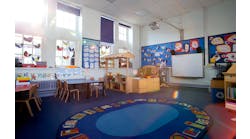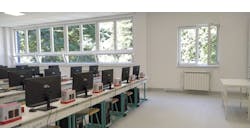A fenestration system that takes maximum advantage of daylighting can have numerous positive effects not only on a school's learning environment, but also maintenance and operations costs. When schools are pitched an alternative to traditional windows, they should sit up and take notice.
Learning brighter
In 1999, the Heschong Mahone Group, an energy-consulting firm in Fair Oaks, Calif., found a correlation between the use of daylighting and student performance on standardized tests. In the Capistrano Unified School District (CUSD) in Orange County, Calif., the students in classrooms with daylighting strategies, large windows or well-designed skylights performed 19 to 26 percent better than their peers in classrooms without these features.
Whether the improved performance resulted from increased light, an improved quality of light, or the positive physiological effect natural light had on the students and teachers is unclear. Regardless, this study suggests that students will perform better with daylighting features in place. Some also believe replacing older, inefficient windows with daylighting systems can improve the performance of the school, as well.
Common scenario
Realistically, many schools operate in older buildings with failing window systems. Students cope with unbearable drafts that force them to wear coats during the winter. Because students are distracted by how cold they are, the lessons being taught may not have the same effectiveness.
To address the window-draft problem, a maintenance staff needs to be trained to identify a problematic window and how to repair it. Parts for the window system may be difficult to replace or impossible to locate, depending on the age of the system and if it is a landmark protected by preservation laws. Consequently, non-historical windows are often boarded up, and windows on buildings that are protected have to be restored.
Often the upkeep of fenestration systems falls to the bottom of the “to-do” list with facility maintenance departments. Staff and budgets are limited, and other maintenance issues sometimes are seen as more important. And, many facilities do not have a structured approach for window maintenance. Repairs and cleaning are performed on an as-needed basis, and inspections rarely are performed. If maintenance issues continue to be ignored, over time a building will begin to show its age.
When it comes time to replace window systems, daylighting such as skylights, should not be overlooked. Well-designed daylighting systems can provide more natural light, reduce the usage of artificial light, and result in improved student performance and free-up maintenance staff's workload, allowing more time to focus on cleaning.
Less work?
Tracking the impact of natural light on academic performance is much simpler than measuring the changes in the amount of maintenance that was needed before and the amount that is needed after the new or improved window systems are installed. If the facility's windows were in poor condition to begin with and did not function properly, then installing a new system will improve heating and cooling efficiency. With these new systems, maintenance staffs will have fewer problems to address, requiring less attention than before.
Constructed in the mid-1990s, four schools in the Johnston County Schools in Smithfield, N.C., were built incorporating daylighting systems. Before construction, there were poorly functioning window systems. Now these schools have large light-wells placed above classrooms, allowing natural light into the classroom.
According to Tom Davis, executive director of new construction and the retired deputy superintendent of Johnston County Schools, Smithfield, N.C., there were few maintenance issues after implementation of daylighting systems in the four buildings.
“There were the standard problems such as caulk that failed, which caused some minor leaks, but for the most part, we haven't had any problems,” says Davis. “It is difficult to say if the amount of maintenance performed has decreased.”
Some facilities however, do notice a difference in maintenance patterns with increased daylighting in place. Although daylighting does not make lighting fixtures obsolete once daylighting is in place, their use is decreased and fewer artificial lights are necessary. Therefore, fewer light bulbs will reduce the number of lighting fixtures and bulbs that require replacement and maintenance.
Brian Johannes, operations manager of the Capistrano District, the district who served as the sample for the Heschong Mahone Group study, says that now his staff can focus on cleaning rather than on the lighting fixtures.
“On many occasions during the day you don't even need to use the lights,” says Johannes. “Because you aren't using the lights as often, fluorescent lights and the ballasts don't need to be replaced as frequently.”
Using more daylighting does not make a system maintenance-free. In fact, other maintenance issues occur when specific types of daylighting are used.
“Some of the light shafts used in classrooms and other areas include shades that can be used to block out the light when it's needed,” says Gene Ingle, director of facility planning, construction and safety at the College of the Desert, Palm Springs, Calif. “The skylights have electronically operated applications, which have parts that can break or wear out and require maintenance.”
Perfect vision
Many skylights and other daylighting methods are in places unreachable without ladders, and therefore they do not receive the same attention as other surfaces. While handprints may not plague skylights, dust and dirt can blur the otherwise beautiful view.
Some facilities may choose to clean their systems on an as-needed basis, much as they did with traditional windows. Others approach cleaning in a more structured manner. Johannes at the Capistrano District says that they clean the skylights on an annual basis.
“Once a year we clean the skylights; they have hinges that allow us to easily clean them,” says Johannes. “The larger ones that measure more than 10 feet in length are located in areas such as the gymnasium. To clean those we usually climb on the roof and hose them down.”
Many of the windows in the daylighting systems at the College of the Desert are designed to prevent bugs and insects from collecting on the skylight glass. An encased light tunnel does not allow debris to enter; therefore, the system does not end up appearing like many lamps and other lighting fixtures.
“A lot of buildings on campus use daylighting, and it really is a lot easier on your eyes. A well-designed system produces no more heat than fluorescent light fixtures,” says Ingle. “With little maintenance required in our systems, we are able to dramatically reduce energy costs and improve the learning environment for the students.”
Hale is assistant editor of AS&U. She can be reached at [email protected].
QUOTABLE
Tom Davis
Executive Director of New Construction and the Retired Deputy Superintendent of Johnston County Schools, Smithfield, N.C.
“There were the standard problems such as caulk that failed, which caused minor leaks, but for the most part, we haven't had any problems.”
Brian Johannes
Operations Manager, Capistrano Unified School District, Orange County, Calif.
“Once a year we clean the skylights; they have hinges that allow us to easily clean them. The larger ones that measure more than 10 feet in length are located in areas such as the gymnasium. To clean those we usually climb on the roof and hose them down.”
Gene Ingle
Director of Facility Planning, Construction and Safety, College of the Desert, Palm Desert, Calif.
“Some of the light shafts used in classrooms and other areas include shades that can be used to block out the light when it's needed. The skylights have electronically operated applications, which have parts that can break or wear out and need maintenance.”

